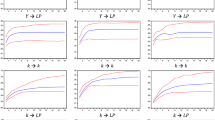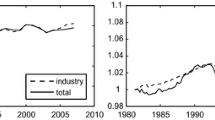Abstract
In this paper we highlight the joint dynamic behavior of three key variables in labor market. Precisely, by means of a structural VAR we employ labor productivity, real wage and unemployment to identify the structural shocks affecting their pattern, in the long and short-run. We will label them as technology, markup and aggregate demand shocks, respectively. The impulse responses of each variable to shocks provide the measure of their (relative) elasticity in explaining the behavior of labor market in six OECD countries, namely Italy, France, Spain, Germany, UK and USA. We find that: (1) the conditional correlations between productivity and real wage are positive for both supply and demand shocks, (2) the impulse responses show a persistent increase of both productivity and real wage to supply shocks, (3) the level of unemployment shows a persistent decrease when hit by a positive demand shock. The main result of our analysis is that Keynesian policies can have permanent effect on the labor market equilibrium.








Similar content being viewed by others
Notes
Following the literature (i.e. in Fischer 1977; Blanchard and Quah 1989; Enders 2014; Calcagnini et al. 2016) we use a structural VAR in discrete time to test our theoretical model. This is a standard procedure. The empirical analysis in continuous time is left for future research (for example, Federici et al. 2012).
Ball et al. (1999) shows that monetary and fiscal can have long-run effects on the level of unemployment.
References
Ball, L., Mankiw, N. G., & Nordhaus, W. D. (1999). Aggregate demand and long-run unemployment. Brookings Papers on Economic Activity, 1999, 189–251.
Balmaseda, M., Dolado, J. J., & López-Salido, J. D. (2000). The dynamic effects of shocks to labour markets: Evidence from OECD countries. Oxford Economic Papers, 52, 3–23.
Blanchard, O., & Galí, J. (2007). Real wage rigidities and the new Keynesian model. Journal of Money, Credit and Banking, 39(s1), 35–65.
Blanchard, O., & Giavazzi, F. (2003). Macroeconomic effects of regulation and deregulation in goods and labor markets. The Quarterly Journal of Economics, 118(3), 879–907.
Blanchard, O. J., & Johnson, D. R. (2013). Macroeconomics (6th ed.). Boston: Pearson.
Blanchard, O. J., Nordhaus, W. D., & Phelps, E. S. (1997). The medium run. Brookings Papers on Economic Activity, 2, 89–158.
Blanchard, O. J., & Quah, D. (1989). The dynamic effects of aggregate demand and supply disturbances. The American Economic Review, 79, 655–673.
Blanchard, O. J., & Summers, L. H. (1986). Hysteresis and the European unemployment problem. In S. Fischer (Ed.), NBER macroeconomics annual 1986 (Vol. 1, pp. 15–90). Cambridge: MIT Press.
Calcagnini, G., Giombini, G., & Travaglini, G. (2016). Modelling energy intensity, pollution per capita and productivity in Italy: A structural VAR approach. Renewable and Sustainable Energy Reviews, 59, 1482–1492.
Calcagnini, G., Giombini, G., & Travaglini, G. (2017). A Schumpeterian model of investment and innovation with labor market regulation. Economics of Innovation and New Technology, 18, 1–24.
Calcagnini, G., & Travaglini, G. (2014). A time series analysis of labor productivity. Italy versus the European countries and the US. Economic Modelling, 36, 622–628.
Clarida, R., & Gali, J. (1994). Sources of real exchange-rate fluctuations: How important are nominal shocks? Carnegie-Rochester Conference Series on Public Policy, 41, 1–56.
Daveri, F., Jona-Lasinio, C., & Zollino, F. (2005). Italy’s decline: Getting the facts right. Giornale degli Economisti e Annali di Economia, 64, 365–421.
Elliott, G., Rothenberg, T. J., & Stock, J. H. (1992). Efficient tests for an autoregressive unit root. NBER Technical Working Papers 0130, National Bureau of Economic Research, Inc.
Elliott, G., Rothenberg, T. J., & Stock, J. H. (1996). Efficient tests for an autoregressive unit root. Econometrica, 64(4), 813–836.
Enders, W. (2014). Applied econometric time series (4th ed.). New York: Wiley.
Federici, D., Saltari, E., Clifford, R. W., & Giannetti, M. (2012). Technological adoption with imperfect markets in the Italian economy. Studies in Nonlinear Dynamics & Econometrics, 16(2), 1–30.
Fischer, S. (1977). Long-term contracts, rational expectations, and the optimal money supply rule. Journal of Political Economy, 85(1), 191–205.
Fuller, W. A. (1996). Introduction to statistical time series. New York: Wiley.
Gali, J. (1999). Technology, employment, and the business cycle: Do technology shocks explain aggregate fluctuations? American Economic Review, 89(1), 249–271.
Gamber, E. N., & Joutz, F. L. (1993). An application of estimating structural vector autoregression models with long-run restrictions. Journal of Macroeconomics, 15(4), 723–745.
Gambetti, L., & Pistoresi, L. (2004). Policy matters. The long run effects of aggregate demand and markup shocks on the Italian unemployment rate. Empirical Economics, 29(2), 209–226.
Giersch, H. (1985). Eurosclerosis. No. 112. Kieler Diskussionsbeiträge.
Gordon, R. J. (1995). Is there a tradeoff between unemployment and productivity growth?. Cambridge: National Bureau of Economic Research.
Kwiatkowski, D., Phillips, P., Schmidt, P., & Shin, Y. (1992). Testing the null hypothesis of stationarity against the alternative of a unit root: How sure are we that economic time series have a unit root? Journal of Econometrics, 54(1–3), 159–178.
Lastrapes, W. D. (2002). Real wages and aggregate demand shocks: Contradictory evidence from VARs. Journal of Economics and Business, 54(4), 389–413.
Marchetti, D. J., & Nucci, F. (2001). Unobserved factor utilization, technology shocks and business cycles. No. 392. Bank of Italy, Economic Research and International Relations Area.
Saltari, E., & Travaglini, G. (2009). The productivity slowdown puzzle. Technological and non-technological shocks in the labor market. International Economic Journal, 23(4), 483–509.
Saltari, E., Travaglini, G., Wymer, C. R. (2010). Investment, productivity and employment in the Italian economy. The Economics of Imperfect Markets (Physica-Verlag HD), 7, 113–136.
Author information
Authors and Affiliations
Corresponding author
Rights and permissions
About this article
Cite this article
Travaglini, G., Bellocchi, A. How supply and demand shocks affect productivity and unemployment growth: evidence from OECD countries. Econ Polit 35, 955–979 (2018). https://doi.org/10.1007/s40888-018-0127-1
Received:
Accepted:
Published:
Issue Date:
DOI: https://doi.org/10.1007/s40888-018-0127-1




